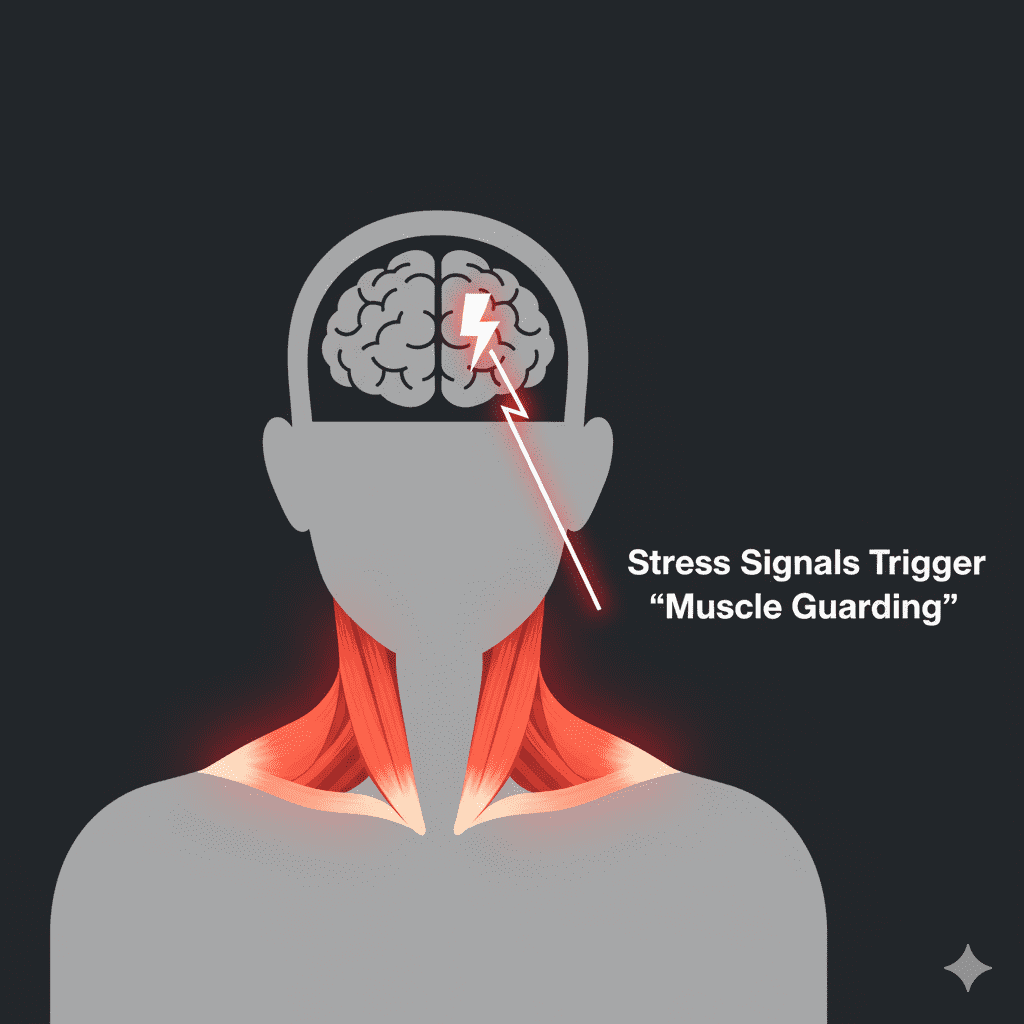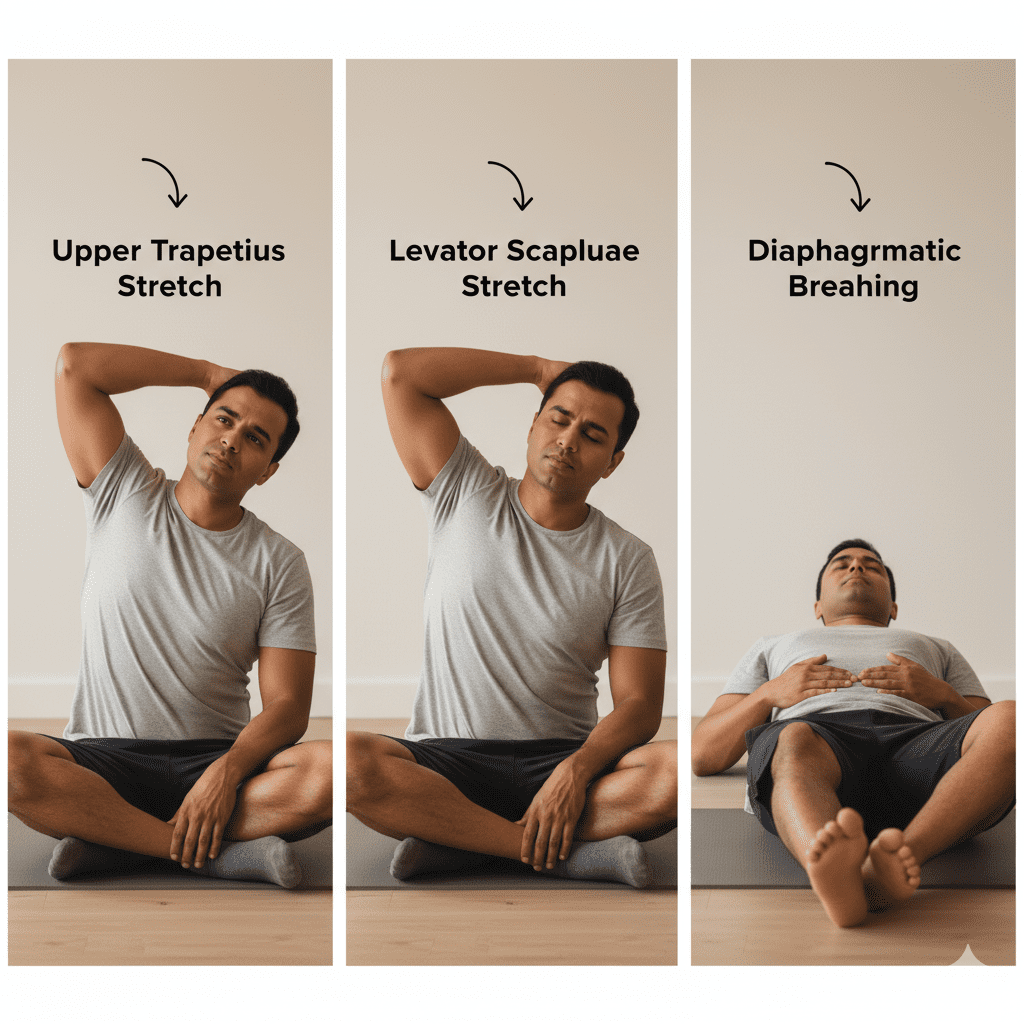It’s 4 PM on a Tuesday. You’ve been staring at a screen for hours, juggling deadlines, answering a constant stream of emails, and navigating a never-ending to-do list. You take a deep breath—or rather, a shallow one—and notice it: that familiar, heavy, burning ache that has settled deep into your neck and across the tops of your shoulders.
You try to roll your shoulders back, but they feel like concrete. You rub your neck, but the tightness feels unshakeable. For so many of us, this has become the default physical state of being busy, stressed, or overwhelmed.
Here is the most important thing you need to know: That tightness in your shoulders after a stressful day isn’t “all in your head”—it’s a real, measurable, and predictable physiological response. Your body is physically reacting to your mental and emotional state. Let’s pull back the curtain on why this happens and, more importantly, what you can do about it.

The Science, Simplified: Why Your Shoulders Carry Your Stress
To understand why your neck and shoulders are the primary victims of a tough day, we need to look at our body’s ancient, hard-wired survival system: the “fight-or-flight” response.
Your Body’s Built-in Alarm System
When your brain perceives a threat—whether it’s a lion in the savanna or a terrifying email from your boss—it triggers a cascade of hormonal changes. Adrenaline and cortisol flood your system, your heart rate increases, and your senses sharpen. Part of this response is a subconscious tensing of your muscles, a phenomenon known as muscle guarding. Your body is preparing to either fight the threat or run from it.
The muscles of your neck, shoulders (specifically the upper trapezius), and jaw are particularly prone to this guarding response. They instinctively tighten to protect your vulnerable neck and head from harm.
When the “Threat” Never Leaves
The problem is, in our modern world, the “threats” aren’t temporary. They are chronic. The stress from work, finances, or family life doesn’t just disappear after a few minutes. This means your body’s alarm system never fully shuts off. Your muscles, particularly those neck and shoulder guards, remain in a constant, low-grade state of contraction. They never get the signal to fully relax.
This creates a vicious cycle:
- Chronic Tension: Your muscles are always slightly “on,” burning energy and becoming fatigued.
- Reduced Blood Flow: Tight muscles constrict the blood vessels within them, reducing the flow of oxygen and nutrients to the muscle tissue.
- Waste Build-Up: This poor circulation also means metabolic waste products, like lactic acid, don’t get flushed out efficiently, leading to irritation and pain.
- Trigger Points: Over time, this chronic tension can lead to the formation of hyper-irritable spots in the muscle fibers, commonly known as “knots” or trigger points. These knots can cause localized pain and even refer pain to other areas, like the head (hello, tension headaches).
- Pain Creates More Stress: The physical pain then acts as another stressor on your body, causing you to tense up even more, perpetuating the cycle.
On top of this, stress changes how you breathe. We shift from deep, efficient belly breaths to shallow, rapid chest breaths. This overworks the smaller “accessory” muscles in your neck and chest, adding yet another layer of tightness and strain.

The Release Routine: 3 Steps to Reclaim Your Neck and Shoulders
While the science might sound complex, the solution can start simply. The goal is to interrupt the pain-tension cycle. These three exercises are specifically designed to target the muscles most affected by stress and to calm your nervous system. Perform them slowly and mindfully.
1. The Upper Trapezius Stretch
Targets: The large “cape” muscle that spans from the side of your neck to the tip of your shoulder. This is the muscle that becomes your “earrings” when you’re stressed. Why it helps: It directly lengthens the primary “shrugging” muscle that is in a constant state of guarding during stressful periods, providing immediate relief from that classic shoulder ache.
- Sit tall in a chair with your feet flat on the floor and your back straight.
- Gently let your right ear drop down towards your right shoulder, keeping the shoulder relaxed and down. Don’t force it.
- To deepen the stretch, you can place your right hand on the top of your head and apply very gentle overpressure.
- Hold the stretch for 30 seconds, breathing deeply and slowly. You should feel a pull along the left side of your neck and into your shoulder.
- Slowly release and repeat on the other side.
Physio Tip: For an even deeper stretch, hold onto the side of your chair with your left hand as you stretch to the right. This helps to anchor the shoulder down and isolate the stretch.
2. The Levator Scapulae Stretch (The “Check Your Armpit” Stretch)
Targets: A deep, rope-like muscle that runs from the top corner of your shoulder blade up to your neck. It’s a major culprit in causing tension headaches at the base of the skull. Why it helps: This muscle gets incredibly tight from hunching and elevating the shoulders. Releasing it can feel like you’ve unlocked your entire neck.
- Sit tall in a chair, facing forward.
- Turn your head about 45 degrees to the right, as if you are looking towards your right knee or armpit.
- Gently tuck your chin down towards your chest.
- Place your right hand on the back of your head and apply gentle pressure, guiding your head further into the stretch.
- Hold for 30 seconds, focusing on your breath. You should feel this stretch in the back-left side of your neck.
- Slowly release and repeat on the other side.
Physio Tip: Imagine you are trying to bring the tip of your nose into your armpit. This helps you get the perfect angle to isolate this tricky muscle.
3. Diaphragmatic (Belly) Breathing
Targets: Your diaphragm and, most importantly, your nervous system. Why it helps: This is not a stretch; it’s a reset button. Shallow chest breathing is a hallmark of the “fight-or-flight” response. Deep belly breathing, on the other hand, stimulates the vagus nerve, which activates your “rest-and-digest” (parasympathetic) nervous system. It sends a powerful signal to your brain that you are safe, allowing your guarded muscles to finally stand down.
- Find a comfortable position, either sitting upright or lying on your back with your knees bent.
- Place one hand on your upper chest and the other on your belly, just below your rib cage.
- Close your eyes and breathe in slowly and deeply through your nose for a count of four. As you inhale, focus on making the hand on your belly rise. The hand on your chest should remain relatively still.
- Pause for a moment at the top of your breath.
- Exhale slowly and completely through your mouth for a count of six. Feel the hand on your belly gently fall.
- Repeat for 2-3 minutes. Notice the growing sense of calm.
Physio Tip: Making your exhale longer than your inhale is the key to maximizing the relaxation response.

From Temporary Relief to Lasting Release
Integrating these stretches and breathing exercises into your daily routine is a powerful way to manage the physical symptoms of stress. They can provide instant relief and help you break the cycle of tension.
However, when stress is chronic, these patterns of muscle guarding can become deeply ingrained. The knots can become stubborn, and the muscles can “forget” how to fully relax.
While these stretches provide excellent temporary relief, chronic stress patterns often require hands-on treatment to fully release the built-up tension and address the root of the pain. Let our expert physiotherapists help you unwind these patterns, release stubborn trigger points, and teach you strategies for long-term resilience.
Your journey to feeling better starts here. Book your initial assessment at Physiogain today.